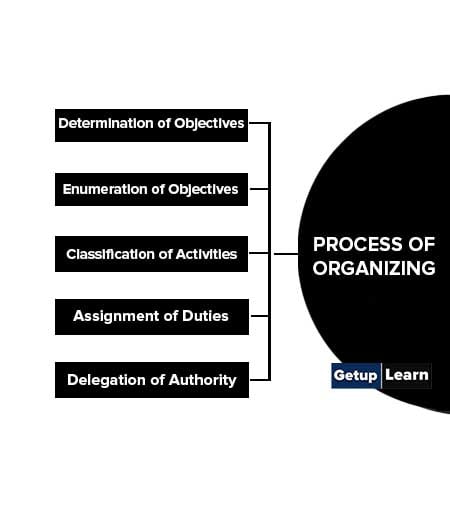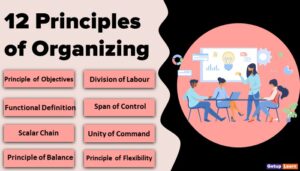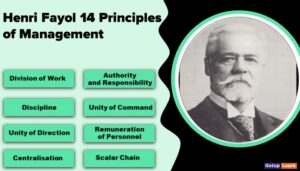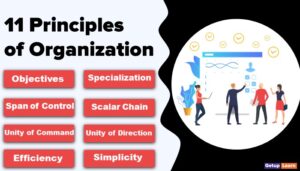Table of Contents
What is Organizing?
Organizing is a process of dividing work into duties, grouping these duties in the form of positions, and grouping these positions in the form of departments. It is an important activity that brings together the manpower and resources for the accomplishment of goals.
It includes the identification of activities, grouping them in logical positions, assigning duties to individual positions, and delegating authority and responsibility to them.
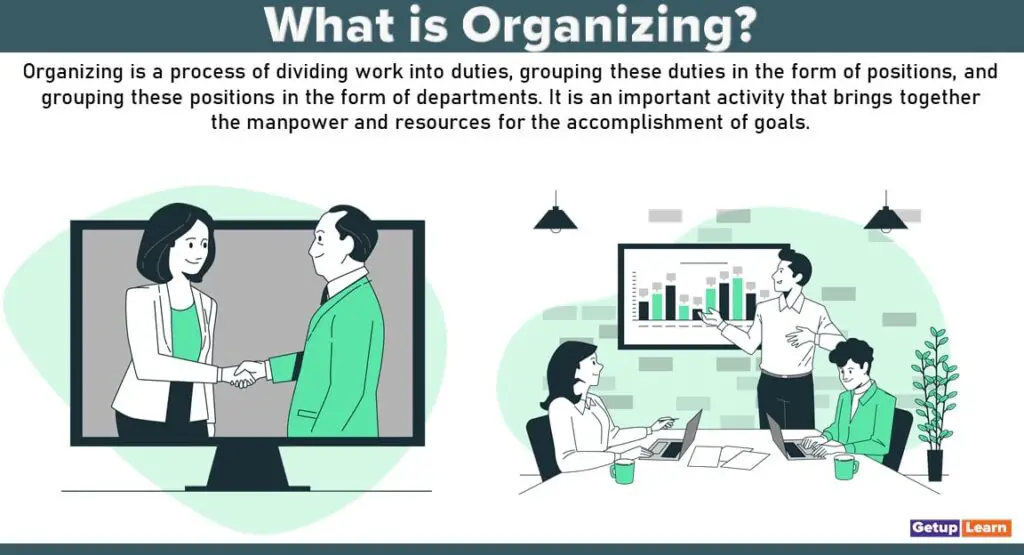
Meaning of Organizing
Organizing is the process of defining and grouping the activities of the business enterprise and establishing authority relationships among them. In performing the organizing function, the manager defines, departmentalizes, and assigns activities so that they can be most effectively executed.
The organization is the foundation upon which the whole structure of management is built. It is the backbone of management. Without organization, the manager cannot function as a manager. The organization is concerned with the development and maintenance of the structure of working relations in order to achieve the objectives of the enterprise.
Organizing means determination and assignment of duties to people and establishment and maintenance of relationships. It is the structural framework within which the various efforts are coordinated and related to each other.
The term organizing is also used as a process carried out for arranging tasks into manageable units and defining the formal relationships among the people working on different tasks.
It involves putting things and persons in proper places and in relation to each other. The success or failure of an enterprise depends largely on the nature of the organization.
Definitions of Organizing
These are the following definitions of organizing by authors:
[su_quote cite=”Louis A. Allen”]Organizing is the process of identifying and grouping the work to be performed, defining and delegating responsibility and authority, and establishing relationships for the purpose of enabling people to work most effectively together in accomplishing objectives.[/su_quote]
[su_quote cite=”Alvin Brown”]Organizing defines the part where each member of an enterprise is expected to perform and the relations between such members, to the end that their concerted endeavor shall be most effective for the purpose of the enterprises.[/su_quote]
[su_quote cite=”Theo Haimann”]Organizing is the process of defining and grouping the activities of the enterprise and establishing the authority relationships among them. In performing the organizing function, the manager defines, departmentalizes, and assigns activities so that they can be most effectively executed.[/su_quote]
[su_quote cite=”Koontz and O’Donnell”]Organizing involves the grouping of activities necessary to accomplish goals and plans, the assignment of these activities to appropriate departments, and the provision for authority delegation and coordination.[/su_quote]
[su_quote cite=”Oliver Sheldonr”]Organizing is the process of combining the work which individuals and groups have to perform with the faculties necessary for its execution so that they provide the best channels for efficient systematic, positive, and coordinated application of the available effort.[/su_quote]
[su_quote cite=”A. Strong”]Organizing is the process of integrating into a coordinated structure of activities required to achieve the objectives of an enterprise; staffing this structure with qualified, competent personnel and supplying them with physical factors necessary to perform their functions.[/su_quote]
Importance of Organizing
Let’s look at the importance of organizing:
- Specialization
- Clarifies Authority and Responsibility
- Avoids Duplication of Work
- Role Clarity
- Source of Support and Security
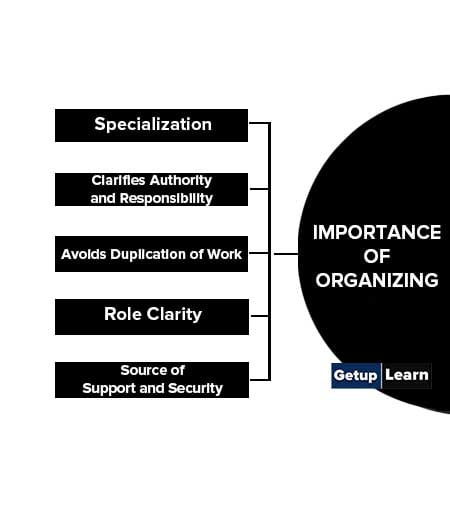
Specialization
Any activity should be grouped based on their similarity and convenience, this leads to efficiency, specialization, and speedy performance of tasks. Division of work helps in bringing specialization in various.
If each manager is aware of his respective powers and privileges, his area of activity, whom he can order, and for which task, it helps to minimize conflicts and confusion.
Avoids Duplication of Work
Organizing helps to avoid duplication of work and overlapping of responsibilities. This is because specific jobs are assigned to individuals and work groups.
Role Clarity
The organizing process clarifies what role a person doing a job is supposed to perform. It is quite often spelled out in a written document called a job description. This helps to avoid duplication of work and Find the right person for the right job.
Source of Support and Security
Organizing is a source of support, security, and satisfaction to managers and employees in performing the task assigned to them. Each member enjoys a definite status in the firm.
Principles of Organizing
These are the following principles of organizing:
- Objectives
- Specialization
- Span of Control
- Exception
- Scalar Principle
- Unity of Command
- Delegation
- Responsibility
- Authority
- Efficiency
- Simplicity
- Flexibility
- Balance
- Unity of Direction
- Personal Ability

Objectives
The objectives of the enterprise should first be clearly defined as it influences the organization’s structure. Each and every employee in the organization should be geared toward the achievement of these objectives.
Specialization
The activities of an organization should be divided according to the functions and these activities must be assigned to persons according to their specialization, which would result in an effective organization.
Span of Control
The number of persons that can be supervised effectively by one boss, should be minimum. It means, that an executive should be asked to supervise a reasonable number of subordinates for an accomplishment of a task.
Exception
The problem which cannot be handled by subordinates at lower levels could be referred to by executives at a higher level with an exception and routine matters should be dealt with by the subordinates at lower levels. It will enable the executives at higher levels to devote time to more important and crucial issues.
Scalar Principle
This principle is sometimes known as the ‘chain of command. The line of authority from the chief executive at the top to the first-line supervisor at the bottom must be clearly defined.
Unity of Command
Each subordinate should have only one superior whose command he has to obey. Dual subordination must be avoided, for it causes uneasiness, disorder, indiscipline, and undermining of authority.
Delegation
The delegation of authority should be proper at the lower levels of the organization also. The authority delegated should be equal to responsibility, i.e. each manager should have enough authority to accomplish the task assigned to them.
Responsibility
Each superior should be held responsible for the acts of his subordinates. So that each superior keeps track of the work done by subordinate and are held responsible for it. No superior should be allowed to avoid responsibility by delegating authority to his subordinates.
Authority is the tool by which a manager is able to accomplish the desired objective. Hence, the authority of each manager must be clearly defined. Authority and responsibility should go hand in hand.
Efficiency
Proper organizational structure enables the enterprise to function efficiently and accomplish its objectives at the lowest possible cost.
Simplicity
The organization structure should be as simple as possible and the organization levels should, as far as possible, be minimum. If levels of the organization are large in number it would lead to difficulty in effective communication and coordination.
Flexibility
The organization should be flexible, should be adaptable to changing circumstances, and permit expansion and replacement without dislocation and disruption of the basic design.
Balance
There should be a reasonable balance in the size of various departments, between centralization and decentralization, between the principle of span of control and. the chain of command, and among all types of factors such as human, technical and financial.
Unity of Direction
There should be one objective and one plan for a group of activities having the same objective. Unity of direction facilitates the coordination of activities at various levels.
Personal Ability
There is a need for proper selection, placement, and training of employees in order to ensure the optimum use of human resources and encourage management development programs.
Process of Organizing
The organization is the process of establishing relationships among the members of the enterprise. The relationships are created in terms of authority and responsibility. To organize is to harmonize, coordinate or arrange in a logical and orderly manner.
Each member of the organization is assigned a specific responsibility or duty to perform and is granted the corresponding authority to perform his duty. The various steps involved in process of organizing:
- Determination of Objectives
- Enumeration of Objectives
- Classification of Activities
- Assignment of Duties
- Delegation of Authority
Determination of Objectives
It is the first step in building up an organization. The organization is always related to certain objectives. Therefore, it is essential for the management to identify the objectives before starting any activity.
Organizational structure is built on the basis of the objectives of the enterprise. That means the structure of the organization can be determined by the management only after knowing the objectives to be accomplished through the organization.
This step helps the management not only in framing the organization structure but also in achieving the enterprise objectives with minimum cost and effort. The determination of objectives will consist in deciding as to why the proposed organization is to be set up and, therefore, what will be the nature of the work to be accomplished through the organization.
Enumeration of Objectives
If the members of the group are to pool their efforts effectively, there must be proper division of the major activities. The first step in organizing group effort is the division of the total job into essential activities.
Each job should be properly classified and grouped. This will enable the people to know what is expected of them as members of the group and will help in avoiding duplication of efforts. For example, the work of an industrial concern may be divided into the following major functions – production, financing, personnel, sales, purchase, etc.
Classification of Activities
The next step will be to classify activities according to similarities and common purposes and functions and take the human and material resources into account. Then, closely related and similar activities are grouped into divisions and departments and the departmental activities are further divided into sections.
Assignment of Duties
Here, specific job assignments are made to different subordinates for ensuring certainty of work performance. Each individual should be given a specific job to do according to his ability and made responsible for that.
He should also be given adequate authority to do the job assigned to him. In the words of Kimball and Kimball, “Organization embraces the duties of designating the departments and the personnel that are to carry on the work, defining their functions and specifying the relations that are to exist between department and individuals.”
Since so many individuals work in the same organization, it is the responsibility of management to lay down the structure of relationships in the organization. Authority without responsibility is a dangerous thing and similarly, responsibility without authority is an empty vessel.
Everybody should clearly know to whom he is accountable; corresponding to the responsible authority is delegated to the subordinates for enabling them to show work performance. This will help in the smooth working of the enterprise by facilitating the delegation of responsibility and authority.
Characteristics of Organizing
These are some important characteristics of organizing:
- Organizing is one of the basic and important elements or functions of management. To get things done by others, a manager has to organize their activities.
- It is a goal-oriented process. It is only to achieve certain goals that the process of organizing is conducted. The structure of an organization is designed to facilitate the performance of a large number of activities.
- The organizing process primarily deals with group efforts, which are made to achieve common goals.
- Organizing is based on the principle of division of work and specialization.
- It involves the processes of differentiation or division of activities and integration of activities by grouping them.
- The process of organizing aims at interrelating, mobilizing, and coordinating the activities of employees.
- It establishes an authority relationship between superior and subordinate among the employees by assigning activities and delegating adequate authority to them.
- It has two basic components or dimensions, namely authority structure, which is created by a delegation of authority from top to lower level, and the activity structure, which is created by dividing activities into jobs and tasks, grouping them, and then assigning them to the various department or individuals.
Features of Organizing
These are the features of organizing given below:
- It is an identifiable group of individuals. The individuals in the group are interrelated with each other on the basis of authority and responsibility.
- It aims at the execution of planning.
-
Organizing divided the total work into activities and functions.
- In an organization all the activities are first divided into units and coordination is established among correlated units.
- The organization is a function that fulfills the common objective.
- Organization refers to defining the structure of duties and responsibilities of persons.
- The organization is a functional concept. 8) Organization is a mechanism of management.
Benefits of Organizing
These are the benefits of organizing:
- Organizing helps an organization make efficient use of its resources and avoid conflict and duplication of effort.
- The process of organizing supports planning and controlling activities by establishing accountability and an appropriate line of authority.
- Organizing creates channels of communication and thus supports decision-making and control.
- The process of organizing helps maintain the logical flow of work activities and also helps individuals and work groups to easily accomplish their tasks.
- The process of organizing helps managers to focus task efforts so that they are logically and efficiently related to a common goal.
- Organizing coordinates activities that are diverse in nature and helps build harmonious relationships among members involved in those activities.
- The process of organizing helps an individual to develop a clear picture of the tasks an employee is expected to accomplish.
What is the meaning of organizing?
Organizing is the process of identifying and grouping the work to be performed, defining and delegating responsibility and authority, and establishing relationships for the purpose of enabling people to work most effectively together in accomplishing objectives.
What is the definition of organizing?
Organizing is the process of defining and grouping the activities of the enterprise and establishing authority relationships among them. In performing the organizing function, the manager defines, departmentalizes, and assigns activities so that they can be most effectively executed.
What is the importance of organizing?
The following are the importance of organizing:
1. Specialization
2. Clarifies Authority and Responsibility
3. Avoids Duplication of Work
4. Role Clarity
5. Source of Support and Security.
What are the principles of organizing?
The following are the principles of organizing:
1. Objectives
2. Specialization
3. Span of Control
4. Exception
5. Scalar Principle
6. Unity of Command
7. Delegation
8. Responsibility
9. Authority
10. Efficiency
11. Simplicity
12. Flexibility
13. Balance
14. Unity of Direction
15. Personal Ability.
What is the process of organizing?
The following are steps of the process of organizing:
1. Determination of Objectives
2. Enumeration of Objectives
3. Classification of Activities
4. Assignment of Duties
5. Delegation of Authority.

